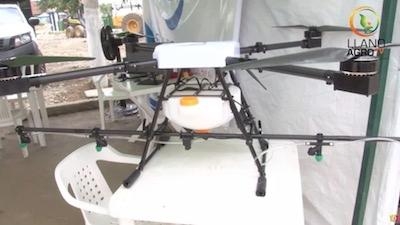Wed, Aug 22, 2018
Ten Drones Being Tested In Nariño Province
The Colombian government is testing a fleet of 10 drones to destroy coca plants that are used in the production of cocaine.

Drone DJ relays a report from the Wall Street Journal which indicates that the new President of Colombia, Iván Duque, prefers using drones over manned aircraft to protect neighboring crops from damage.
The tests are being conducted in the southwestern portion of Nariño province. The drones carry the herbicide Glyphosate, a defoliant, and spray the coca plants with far greater accuracy than could be achieved using more traditional methods. The previous President of Colombia, Juan Manuel Santos, had halted spraying by 14 crop duster airplanes after local farmers filed lawsuits who were concerned about their health. Glyphosate has been linked to some cancers by the World Health Organization.
The U.S. EPA has said that glyphosate is "unlikely" to cause cancer. The chemical has been part of a $10 billion foreign aid package called "Plan Colombia". Use of the chemical reduced the country's coca fields from 470,000 acres in 2001 to 193,000 acres in 2012. But by 2017, the acreage had again increased 160 percent to 516,000 acres.
The drones have been provided by Fumi Drones SAS. German Huertas, director of operations at Fumi Drone says that the aircraft can eliminate about 90 percent of the crops on every acre of coca plants. They also fly lower to the ground, and do not pose a safety hazard to pilots flying close to the ground, Huertas said. The company is also training local police to fly the aircraft.
The downside is that the drones carry a much smaller load of the defoliant than a crop duster, and police must cordon off an area to be sprayed to prevent local farmers from being exposed or cocaine manufacturers from shooting them out of the air. There are also a large number of landmines buried in many regions from a long rebel conflict in Colombia, which can pose additional threats to soldiers and drone pilots.
(Image provided by Llano AgroTV)
More News
Back-Taxi A term used by air traffic controllers to taxi an aircraft on the runway opposite to the traffic flow. The aircraft may be instructed to back-taxi to the beginning of the>[...]
“Our WAI members across the nation are grateful for the service and sacrifice of the formidable group of WASP who served so honorably during World War II. This group of brave>[...]
“Many aspiring pilots fall short of their goal due to the cost of flight training, so EAA working with the Ray Foundation helps relieve some of the financial pressure and mak>[...]
Blind Speed The rate of departure or closing of a target relative to the radar antenna at which cancellation of the primary radar target by moving target indicator (MTI) circuits i>[...]
Aero Linx: International Airline Medical Association (IAMA) The International Airline Medical Association, formerly known as the Airline Medical Directors Association (AMDA) was fo>[...]
 ANN's Daily Aero-Term (05.19.24): Back-Taxi
ANN's Daily Aero-Term (05.19.24): Back-Taxi Aero-News: Quote of the Day (05.19.24)
Aero-News: Quote of the Day (05.19.24) Aero-News: Quote of the Day (05.20.24)
Aero-News: Quote of the Day (05.20.24) ANN's Daily Aero-Term (05.20.24): Blind Speed
ANN's Daily Aero-Term (05.20.24): Blind Speed ANN's Daily Aero-Linx (05.20.24)
ANN's Daily Aero-Linx (05.20.24)



